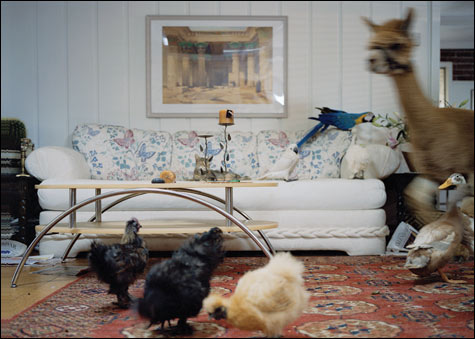
DO YOU LIVE IN A BARN? Schnitt’s Once Upon a Time. |
Corinna Schnitt's video Once Upon a Time opens on a comfortable living room. The camera, mounted near the floor, slowly spins around taking in a bookshelf, fireplace, TV, plants, a white sofa. A black cat pads by. Then another cat walks in, and two more run through. More critters magically appear. A blonde dog sniffs a cockatoo, and then drinks out of the goldfish bowl. A macaw perches on the couch. A goat munches a potted ficus tree.
Seen in the German video artist's show "Once Upon a Time" at the RISD Museum (224 Benefit Street, Providence, through November 6), the 2005 video is funny and poetic and dreamlike, like a Grimm's fairy tale combined with Edward Hicks painting Peaceable Kingdom, which was based on the prophet Isaiah's prophesy of a messianic king who was so just that his leadership would inspire lions and lambs to lie down together in peace.
As more creatures arrive and seemingly multiply, the menagerie gets out of hand. Rabbits crap all over the floor; the cockatoo and a kitten scrap; critters knock over plants and scatter magazines; a cow drinks from the fish bowl; a goat gets up on the couch. Then the animals slowly depart.
This performance of wildness and domestication is the most memorable of the five strong videos here — though not the most pointed. Its narrative progression is apparent from early on, but the 25-minute video seems to keep one-upping itself, as larger and larger domesticated critters appear. It is logical and yet any moral to the story remains elusive. Instead it's a wonder.
Other videos use shots of women cleaning homes, clothes, even street signs to question roles dictated for women. Surreal twists prompt you to question the seeming normalicy of this gendered division of labor.
Living a Beautiful Life (2003) features alternating shots of a husband ("I'm a fighter pilot with the US Navy") and wife in a well-appointed house speaking about the comforts of their life — perfect weather, a mansion, a safe neighborhood, "we have a close inner bond," a live-in maid, a nanny, summer houses, island vacations. "I consider myself a model citizen and my family attends church every week," the man says. The footage is dry and the monologues too neat, but it feels like a contemporary white knight and princess fantasy. Then the husband says, "I enjoy having a mistress, a hot mistress every few months, and then its over. It's important to have something to look forward to every day." You're struck by his nonchalant expectation that all his desires will be satisfied as if he's somehow owed them.

MISCOMMUNICATION An image by the Astrodime Transit Authority. |
"Now and Then and When," organized by Bebe Beard at Rhode Island College's Bannister Gallery (600 Mount Pleasant Avenue, Providence, through April 27), aims to channel something about telecommunications and graphing, I think, but the exhibit is all set-up and little payoff.